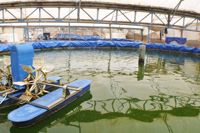Thursday, April 18, 2024
News and Views from the Global South
MIDEAST: From the Sea to the Pond
 Print
|
Print
|
Eva Bartlett
SHEIK RAJLEEN, GAZA, Jul 4 2011 (IPS) - “Farmed fish are now better than sea fish in Gaza. They shouldn’t be, but because of the sewage in Gaza’s sea and the Israeli fishing restrictions, farmed fish are cleaner and healthier than sea fish.”
“It is almost impossible for our fishermen to fish in the sea, so fish farms provide another source of salt water fish.”
Compared to the late 1990s, before the Israeli-led siege choking Gaza since Hamas’s election in 2006, fishermen’s catches are meagre, from a former over 3,500 tons per year to the current less than 500 tons a year. Fishermen, forced by Israeli gunfire to fish within less than three miles, at the same time deplete future stocks of fish.
And, as Ekhail said, the fish caught are polluted, swimming in the sewage that is daily pumped into Gaza’s sea for want of treatment facilities.
“Anyway Gaza is already importing frozen fish from Egypt via the tunnels,” Ekhail points out. There is a growing need for edible fish.
Related IPS Articles
His six pools contain hundreds of maturing fish, a process which takes around eight to 10 months. “But with the power cuts, its taking longer than 10 months,” he says.
Large, electricity powered water wheels spin over the surface of each pool, oxygenating the salt water pumped from underground, and emptied twice a day into the sea.
Among three varieties of fish, the red and silver tilapia are the most popular and his cheapest, at 25 shekels (eight dollars) per kilo. But this is a price the vast majority rendered aid-dependent in Gaza cannot afford.
“We sell mainly to restaurants,” he says, though some families with the means to do so buy from the farm.
The Ekhail fish farm has problems other than the power outages.
“Customers buy frozen fish from Egypt instead of ours, because it’s cheaper,” he says. “And the pellets we feed the fish come from Israel. They are often delayed.”
The greatest problem was the complete destruction of the Ekhail fish farm during the 2008-2009 Israeli war on Gaza. “It was bulldozed, everything destroyed.”
Rebuilt on its rented plot of land, the fish farm is just five minutes by car outside Gaza city. Sea waves crash 50 metres beyond the tent-shaded pools, the paradox of Gaza’s off-limits sea audible and visible.
The region has a history of dependency on the rich catches of the sea, something reflected in the fish- based meals traditional to Gaza and the legacy of fishermen in trawlers, speedboats, and hand-paddled boats the size of a canoe.
The development of aquaculture reflects the continued ingenuity of Palestinians in Gaza, determined to create sources of employment and food in the face of the ruthless, internationally backed Israeli siege on Gaza.
But the rise of aquaculture also reflects the continued international apathy to the plight of Gaza’s roughly 4,000 fishermen who, on a daily basis, are shot at, shelled at, water cannoned with an excrement-scented chemical, and abducted by the Israeli navy from within Palestinian waters.
The 20 nautical miles accorded to Palestinians under Oslo are now an Israeli-reduced less than three miles fishing limit. Many fishermen have been killed or seriously injured while fishing in waters within the Israeli-decreed limits. Hundreds are abducted from Palestinian waters by the Israeli navy every year, an attempt to discourage fishermen from plying their trade.
Aside from the human toll of the Israeli fishing restrictions, there is an economic toll very real to the 65,000 people that the World Food Project (WFP) says are directly affected by the fishing limitations. And there are the 80 percent of food-aid dependent Palestinians in Gaza for whom fish were a source of nutrition sporadically afforded.
With current catches inadequate and much of the available fish farmed or imported, most families can no longer afford the luxury of the protein fish provides.
Whereas aid organisations like WFP and others encourage fish farming in Gaza to provide an alternative source of nutrition to the 1.6 million residents of the Strip, aquaculture is an inadequate temporary fix, not a solution.
It is a fix that, intentionally or not, works in tandem with the Israeli-led siege on Gaza: to deprive Palestinians of their self-sufficiency and their fishing skills passed on through the generations. And it is a fix that does not address the roots of the problem: the siege and the Israeli navy’s lethal games in Palestinian waters, both combined to render Palestinians in Gaza dependent on hand-outs.
 Print
|
Print
|
Related Tags
Editors' choice
Better Incentives Needed to Expand Solar Energy in Cuba

Luis Brizuela | Latin America & the Caribbean
Pictures for this story
This story includes downloadable print-quality images -- Copyright IPS, to be used exclusively with this story.
Most popular
World Says Goodbye To a Caribbean Literary Giant
SWAN | Arts | EuropePioneering Digital Initiative Empowers Pacific Islands to Tackle Climate Disasters
Catherine Wilson | Pacific Community Climate Wire | Asia-PacificThe Climate Alarm Is Ringing – It’s Time to Stop Silencing It
Andrew Firmin | GlobalIPCI 2024: Oslo Commitment Protects Sexual and Reproductive Rights Across All Contexts
Naureen Hossain | Population | GlobalConflict’s Long Shadow Has a Name: It’s Hunger
Charles E. Owubah | Africa




